Home / Nucleophilic Aromatic Substitution (2) – The Benzyne Mechanism
Reactions of Aromatic Molecules
Nucleophilic Aromatic Substitution (2) – The Benzyne Mechanism
Last updated: June 29th, 2025 |
In this article we’ll discuss nucleophilic aromatic substitution, but with a new twist; a nucleophilic aromatic substitution that passes through a strange-looking intermediate called an aryne (a generic term for a family of molecules that includes benzyne).
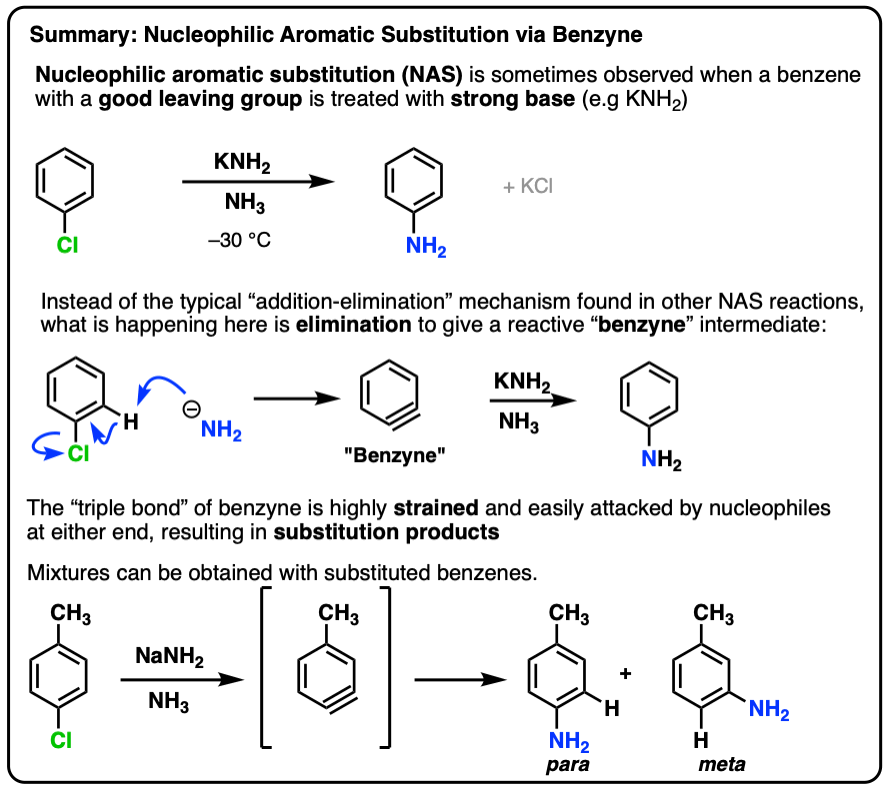
Table of Contents
- Nucleophilic Aromatic Substitution – A Quick Recap
- A “Nucleophilic Aromatic Substitution” In Name, But By A Different Mechanism
- The “Benzyne” Intermediate
- Reaction of Substituted Benzyne – “Arynes”
- Benzyne Undergoes Diels-Alder Reactions
- The Structure of Benzyne
- Summary: Nucleophilic Aromatic Substitution via Benzyne
- Notes
- Quiz Yourself!
- (Advanced) References and Further Reading
1. Quick Recap: Nucleophilic Aromatic Substitution
Previously [see: Nucleophilic Aromatic Substitution] we saw that electron-poor aromatic rings containing a leaving group can undergo substitution with electron-rich nucleophiles. We saw that the mechanism proceeds through addition of a nucleophile to the aromatic ring (via an electron-rich intermediate) followed by loss of a leaving group, in a process sometimes called, “addition-elimination”.
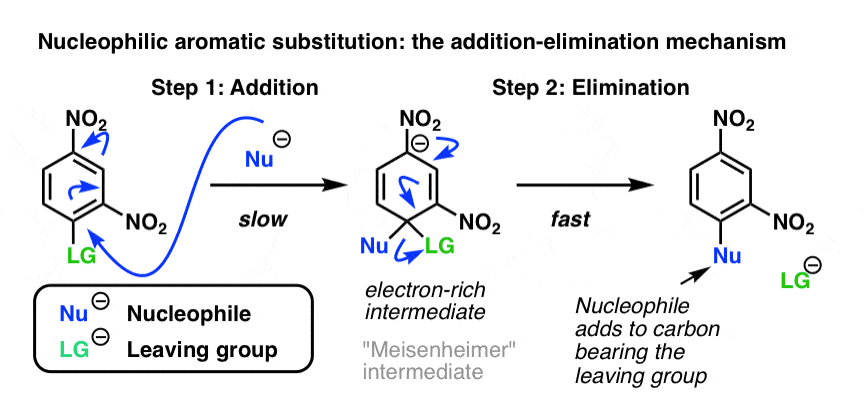
Importantly, the only substitution product is the one where the nucleophile ends up attached to the same carbon as that bearing the leaving group. (This differentiates it from electrophilic aromatic substitution, where a mixture of ortho-, para– and meta- products can be obtained.)
2. A “Nucleophilic Aromatic Substitution” In Name, But By A Different Mechanism
Although the “addition-elimination” mechanism for nucleophilic aromatic substitution has been known since at least 1902 , it became increasingly clear in the first half of the twentieth century that certain reactions classified as “nucleophilic aromatic substitution” appeared to proceed through a different mechanism altogether.
For example, it was found that treating chlorobenzene with sodium amide (NaNH2) in liquid ammonia (boiling point = –33°C) resulted in the rapid formation of aminobenzene (“aniline”):
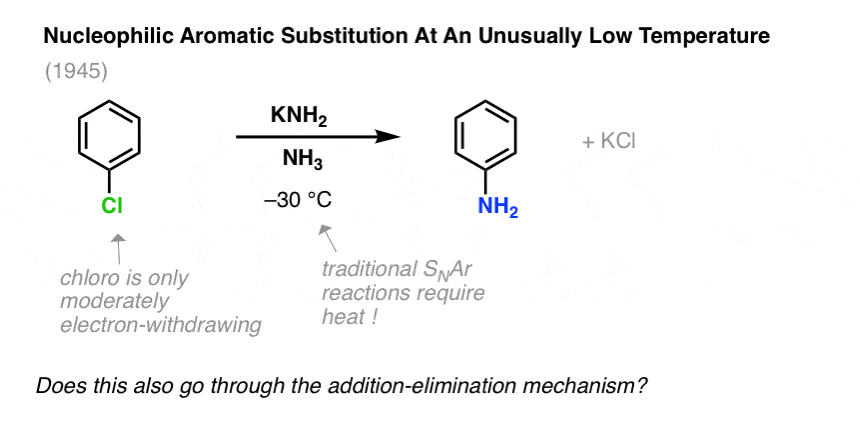
An addition-elimination mechanism here doesn’t seem right, considering that nucleophilic aromatic substitution reactions with far stronger electron withdrawing groups (e.g. NO2, rather than Cl) require higher temperatures and longer reaction times.
Another observation was that no reaction occurred under these conditions when the ortho- positions were attached to alkyl groups. A hydrogen is necessary at one of these positions for the reaction to proceed.
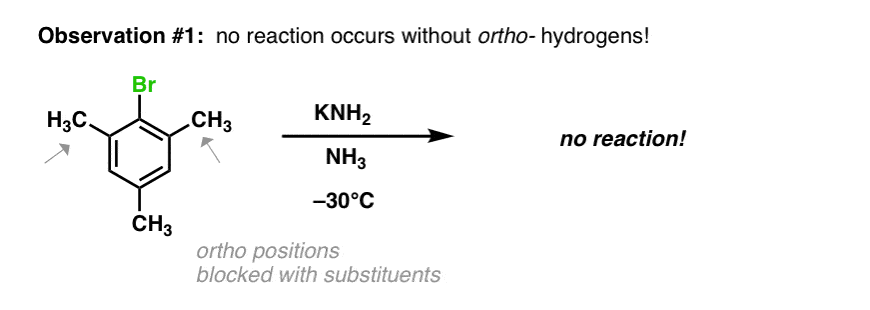
(note – NaNH2 and KNH2 can be considered to be essentially the same for our purposes)
A second observation was that in the case below only the ortho- and meta- products formed, and never the para– .
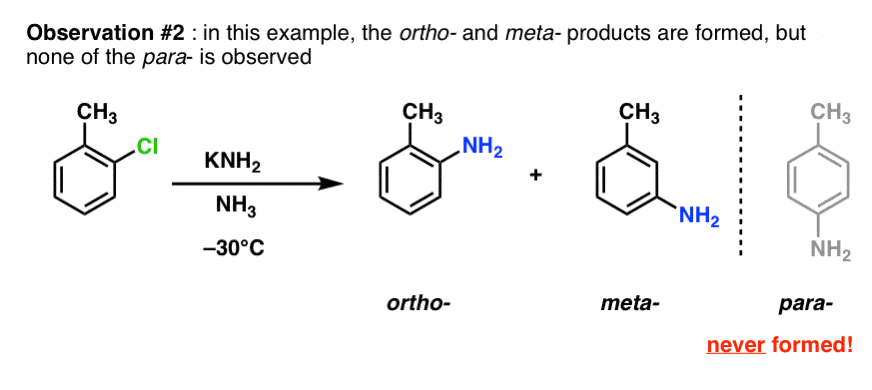
3. The Benzyne Intermediate
Various intermediates were proposed to explain these results, but then in 1953 John D. Roberts (then at MIT) nailed it by publishing one of the most elegant chemical experiments of all time.
He and his team synthesized chlorobenzene but with a special difference: the carbon attached to the chlorine was a radioactive isotope of carbon (14C), not carbon (12C).
This radioactive carbon atom served as an atomic “label”, which allowed them to conclusively determine if substitution happened exclusively at the carbon bearing the leaving group. (how? [Note 4])
Roberts’ group carried out the reaction under conditions reported previously, and found that about 50% of the product ended up with the NH2 attached to the labelled carbon, and the other 50% had the NH2 on the carbon adjacent to the label.
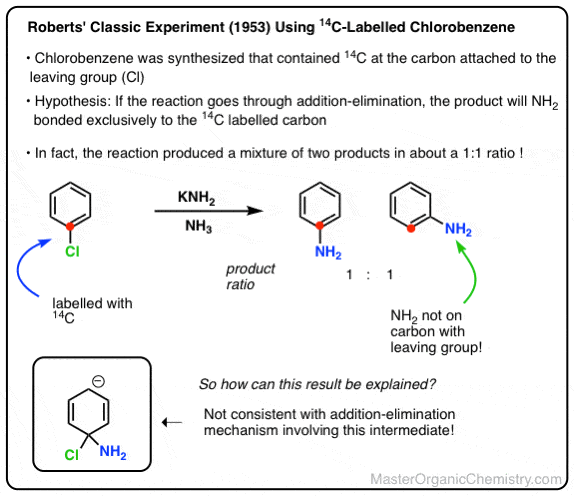
This is not consistent with an addition-elimination mechanism!
In fact, the roughly 50:50 ratio of products implies the involvement of a symmetrical intermediate which is attacked equally on either side.
Roberts’ proposal – which has stood the test of time – was the involvement of a short-lived intermediate bearing a carbon-carbon triple bond: “Benzyne” !

At first glance, this seems crazy. A triple bond in an aromatic ring?
Well, it’s not quite a true triple bond in the way that we’re familiar with (i.e. with alkynes). Instead of an overlap between two 2p orbitals (as in an alkyne) the “triple bond” is formed through overlap of two adjacent sp2 orbitals in the plane of the ring (i.e. at right angles to, and completely independently of, the aromatic pi system).
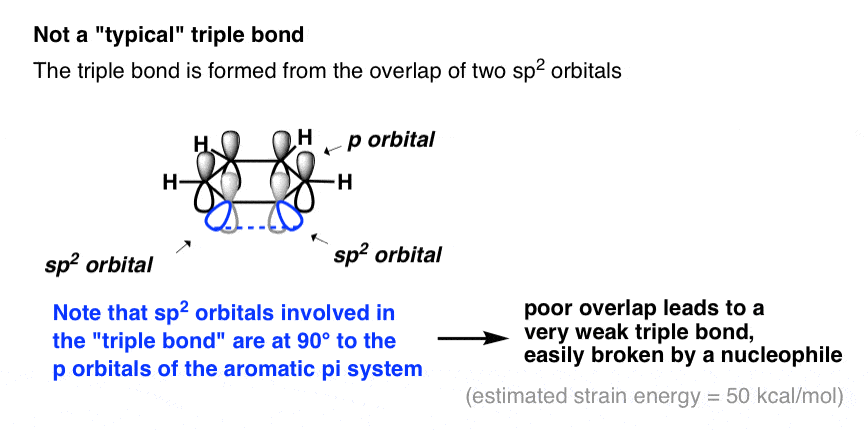
Since these orbitals actually point away from each other, the overlap between them is poor, resulting in a “triple bond” that is actually very weak.
The strain energy of benzyne has been estimated to be about 50 kcal/mol – more strained than cyclopropane (28 kcal/mol), and only slightly less strained than cyclopropene (54 kcal/mol).
An intuitive way to think about it is to imagine the involvement of two resonance structures (far left and far right, below) that make strong (and equal) contributions to the overall resonance hybrid, such that both carbons can be considered “electrophilic”.
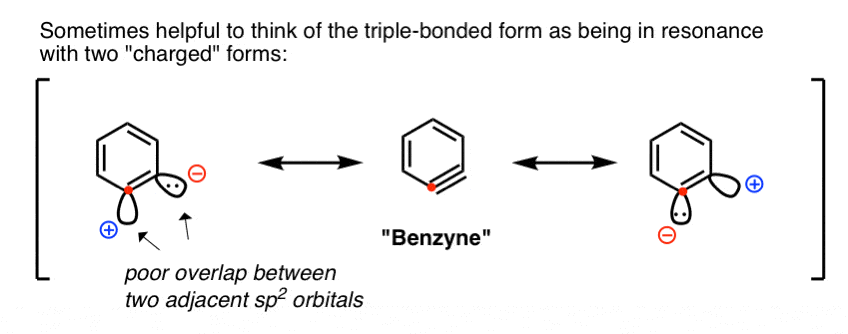
[A more rigorous way to treat it is from a molecular orbital perspective – a weak bond results in a low-energy LUMO, and therefore a lower energetic barrier to attack by nucleophiles].
However strange it might look, the benzyne intermediate explains all of these important observations, and more.
- In the first step (elimination) a strong base removes a hydrogen from the carbon adjacent to that bearing the leaving group, resulting in an elimination reaction that forms the triple bond. This explains why no reaction occurs when both positions adjacent to the leaving group lack hydrogen!
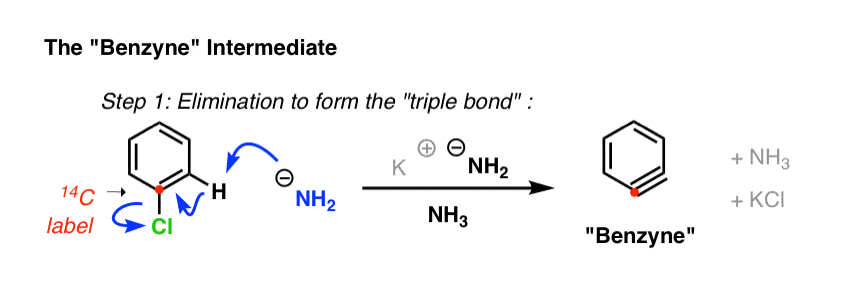
- In the second step (addition), attack of the can come at either side of the triple bond, resulting in about a 1:1 mixture of the product with NH2 attached to the labelled carbon (A) and NH2 adjacent to the labelled carbon (B).
Although it’s tempting to use –NH2 as nucleophile, the more likely nucleophile here is the solvent, NH3, which readily reacts with the extremely reactive benzyne intermediate. After attack of NH3, proton transfer occurs to result in the neutral product. [note that although intramolecular proton transfer is shown below, it’s also possible to show it occurring through an intermolecular mechanism]
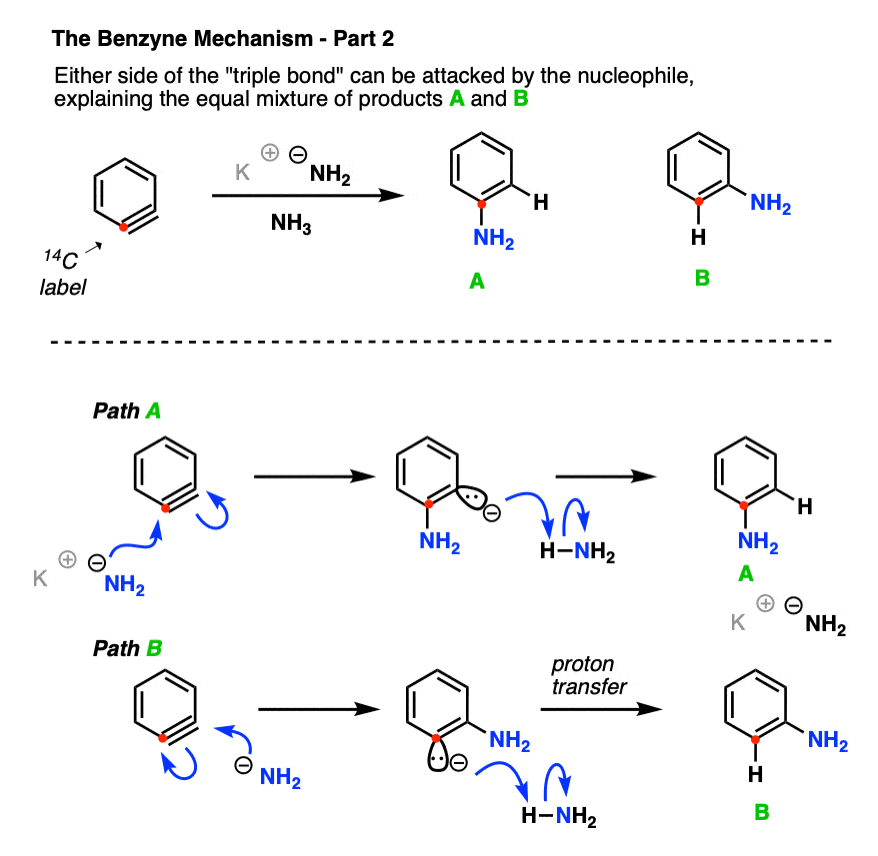
4. Reactions Of Substituted Benzyne (“Arynes”)
What happens when a substituent is present on benzyne? [Note: Just like substituted compounds of benzene are called “arenes”, substituted benzynes are called “arynes”. ]
When a substituent is present, an unsymmetrical aryne will result, and at least two products (and sometimes three) can potentially form. In the example below, attack of NH3 at carbon A results in the ortho product, and attack of NH3 at carbon B results in the meta product.
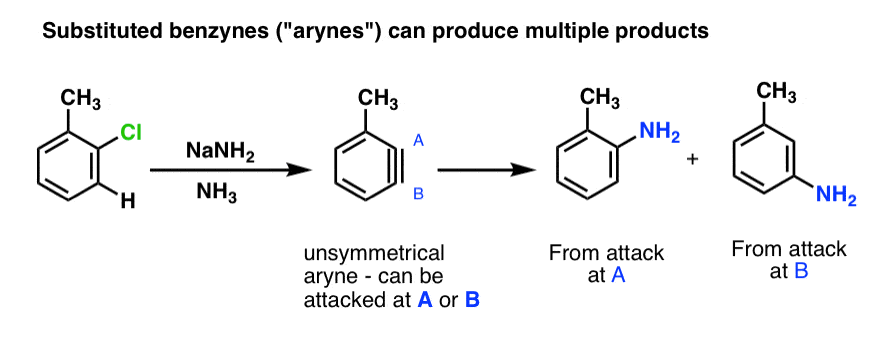
So how do substituents on the ring affect addition to the triple bond?
Since the aromatic pi-system is at right angles to the triple bond, what’s NOT relevant is the ability to donate a lone pair to the ring (like OCH3) , or accept a lone pair from it (like NO2).
However, inductive effects are still relevant (i.e. electron-withdrawing effects that occur through single bonds).
Why? Addition to the triple bond creates a negative charge on carbon, and electron-withdrawing groups stabilize negative charge: the closer, the better.
So a key principle in the addition of nucleophiles to arynes is that addition tends to happen so as to place the negative charge closer to an electron-withdrawing substituent.
Two key examples.
- When the triple bond is between the meta and para carbons, attack will favor the para product, since the negative charge ends up on the meta carbon (closer than para).
- When the triple bond is between the ortho and meta carbons, attack will favor the meta product, since the negative charge ends up on the ortho carbon (closer than meta)
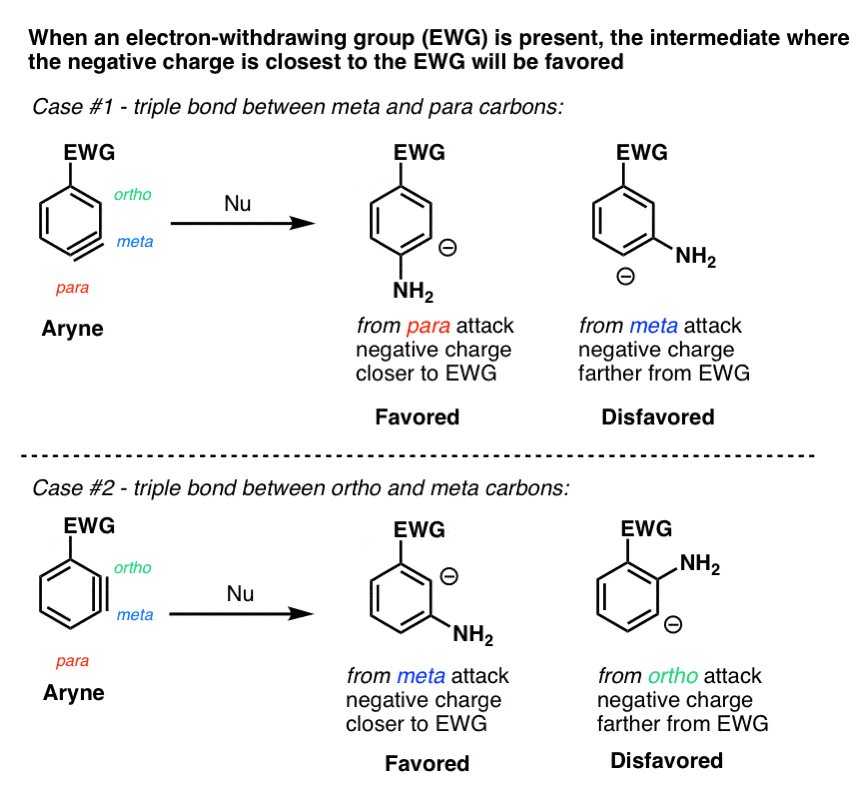
Note that this only applies for electron-withdrawing groups like CF3, not electron-donating groups like CH3 or alkyl. What’s interesting is that OCH3 behaves like an electron-withdrawing group in these examples, since the oxygen lone pairs can’t interact with the triple bond.
See the [Note 1] for some more examples.
5. Benzyne Undergoes Diels Alder Reactions
Benzyne can also react with dienes in Diels-Alder reactions. The triple bond of benzyne acts as a dienophile:
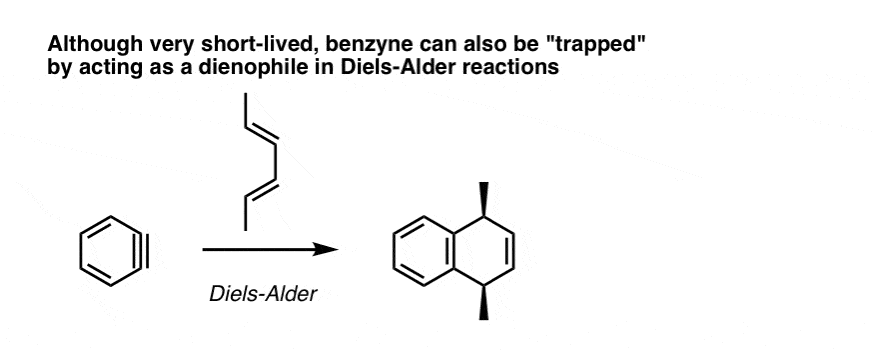
6. The Structure Of Benzyne
For many years benzyne defied attempts at isolation and characterization, its existence inferred through trapping experiments with nucleophiles or dienes. It lives fast and dies young.
Eventually, benzyne was trapped at 6K (i.e. six degrees above absolute zero) in frozen argon and studied through various spectroscopic methods. The triple bond is about 1.26 Å, longer (and weaker) than that in ethyne (1.20 Å) and the adjacent C-C bond is about 1.38 Å , slightly shorter than that in benzene.

(See reference). All the other C-C bonds are within 0.01 Å of the bond lengths in benzene.
7. Summary: Nucleophilic Substitution Reactions Via Benzyne
There is one final type of aromatic substitution reaction for us to consider – a family of reactions called the Sandmeyer reaction that uses nitrogen gas (N2) as the leaving group. More on that next time.
Next Post: Reactions of Diazonium Salts and The Sandmeyer Reaction
Notes
Related Articles
- Nucleophilic Aromatic Substitution (NAS)
- Electrophilic Aromatic Substitution – The Mechanism
- Understanding Ortho, Para, and Meta Directors
- Reactions of Diazonium Salts: Sandmeyer and Related Reactions
- Nucleophilic Aromatic Substitution Via Arynes (MOC Membership)
- Electrophilic Aromatic Substitution Practice Problems (MOC Membership)
- Some other examples of substitution
- Methods for generating benzyne
- Roberts’ degradation study
Some other examples of substituted benzynes
When an aryne is made from p-chlorotoluene, a mixture of para and meta products is obtained.
When an electron-withdrawing substituent like CF3 is used instead of CH3, more of the para is formed – about 60:40, favoring the para. (Statistics would favor the meta by 2:1).
This is because attack at the para position places the negative charge closer to the electron withdrawing group.
Interestingly, OCH3 gives about the same ratio as CF3 (60:40). This means that oxygen is acting purely as an electron-withdrawing group, not a pi-donor. (Further proof that the oxygen lone pair can’t interact with the triple bond. )
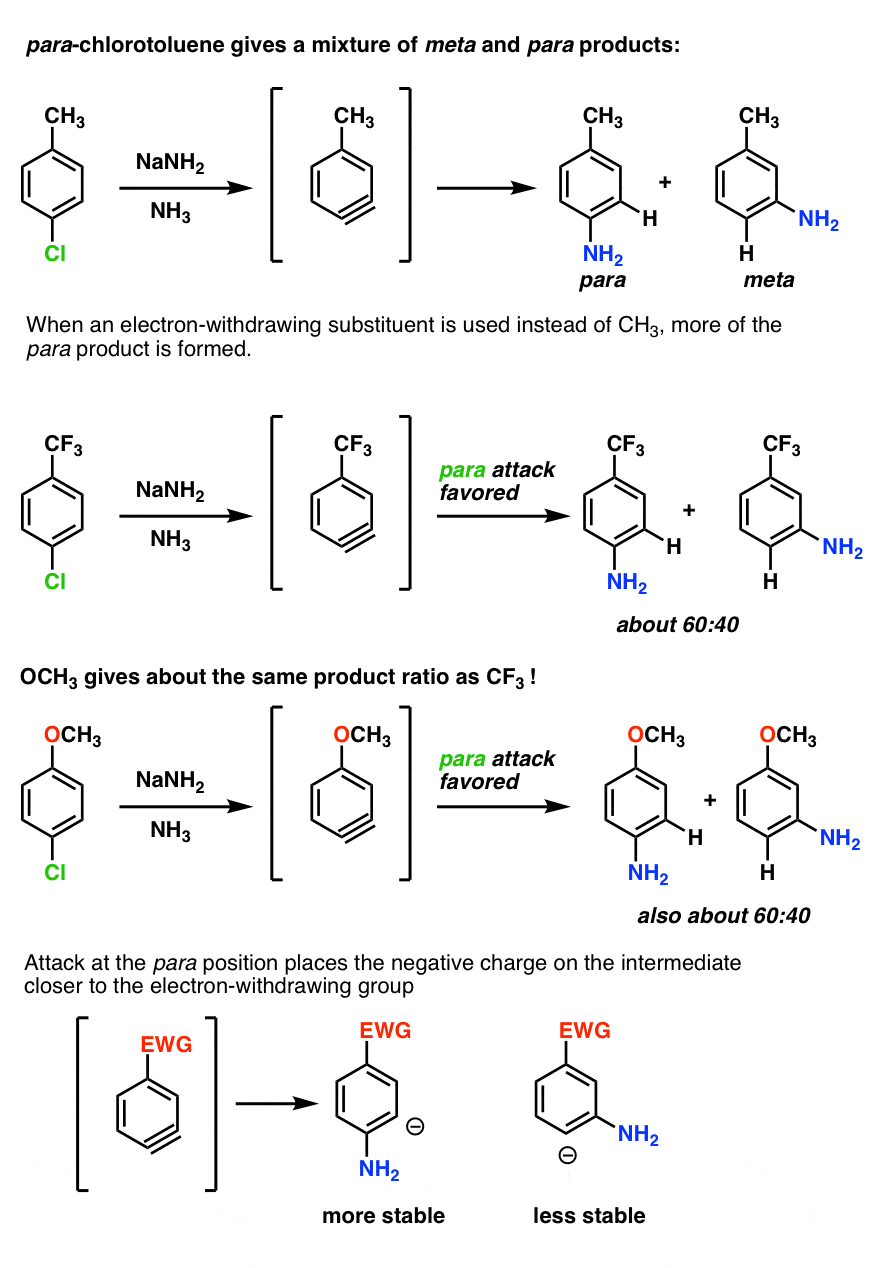
With the ortho-series, the results are even more dramatic. With CH3, about an equal mixture of ortho and meta products is obtained. With CF3 and OCH3, only the meta is observed.
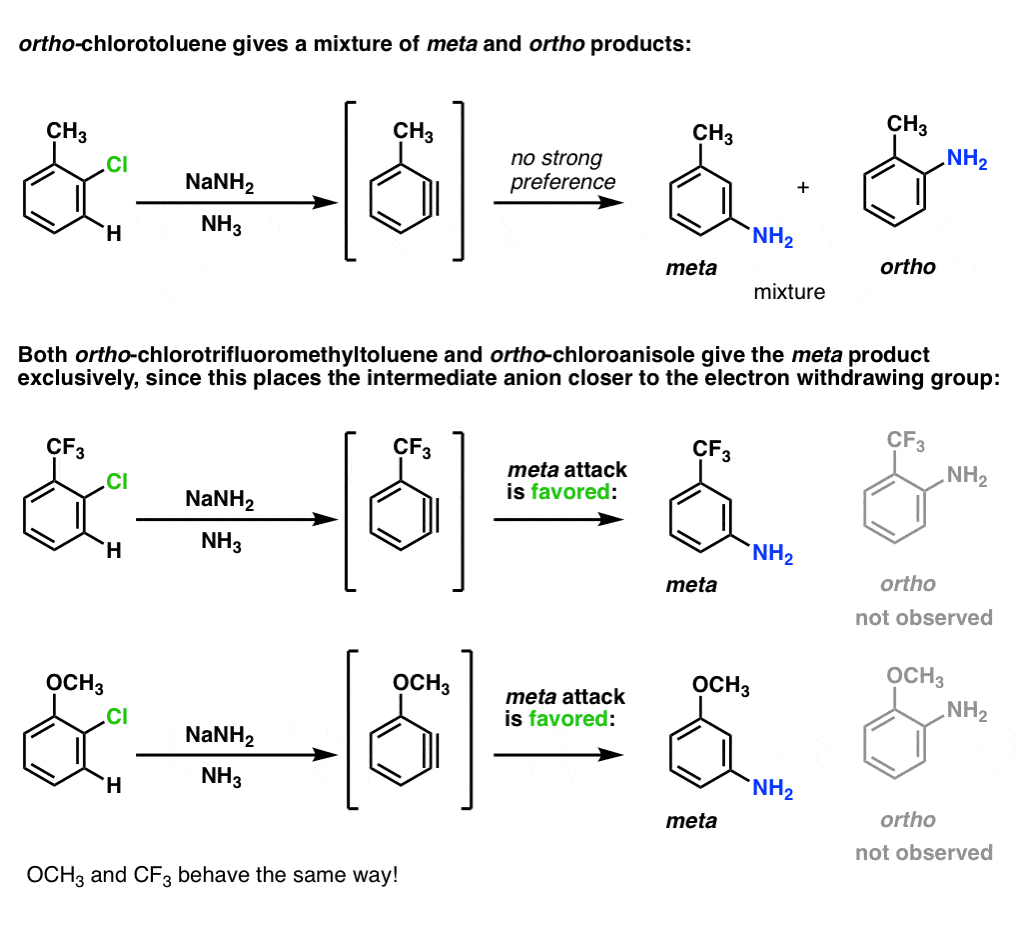
Some ways of generating benzyne
Benzyne can be generated in several other ways besides deprotonation with a strong base like NaNH2 or KNH2.
Grignard reagents behave much like carbanions. So a different path to benzyne formation is to start with a dihalobenzene like o-bromofluorobenzene and treat it with magnesium metal. The Grignard forms, and then this “anion” can displace even a good leaving group like fluorine to give the triple bond:

Another path is to generate a leaving group that can leave irreversibly as a gas, like CO2 or N2.
In the first reaction below, UV light breaks the weak O-O bond, and then homolytic dissociation results in loss of two CO2 molecules to give benzyne.
In the second example, commercially available (and cheap) anthranilic acid is converted into a diazonium ion with HNO2 and HCl. Heat results in loss of CO2 and N2:
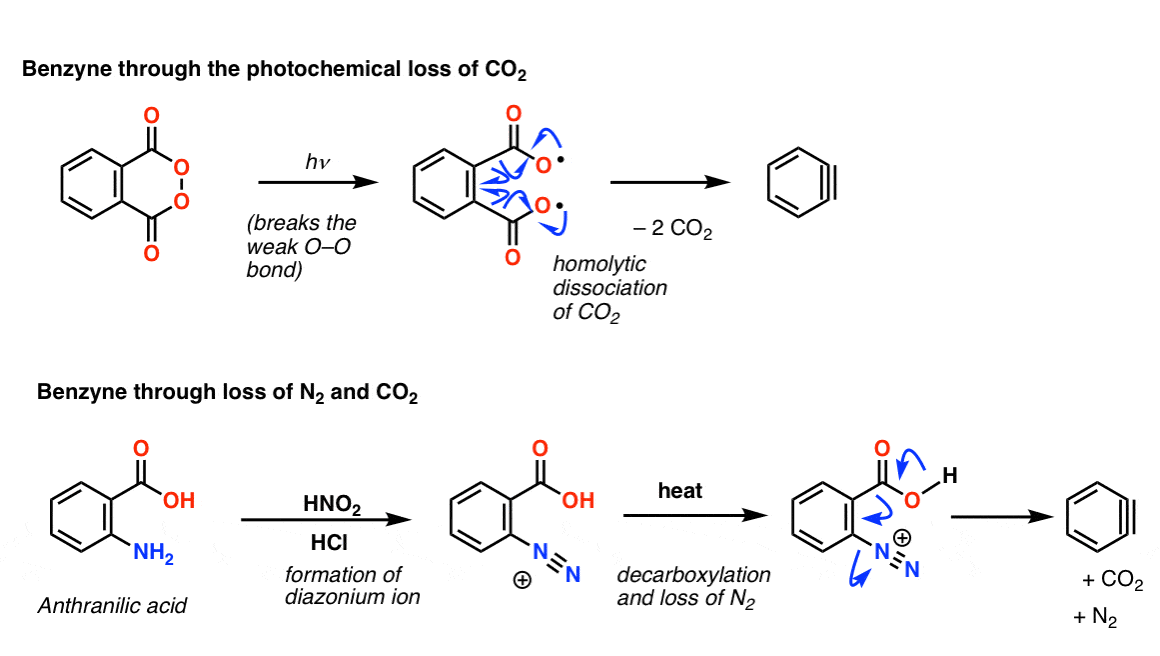
This is just the tip of the iceberg. For more reading, this presentation on arynes by Eric Welin of the Macmilllan group at Princeton is an excellent introduction.
Degradation study.
Today, the results of Roberts’ labelling experiment could be determined in about 5 minutes through a technique called Nuclear Magnetic Resonance, or NMR.
But in 1954, this technique didn’t exist. So it was necessary to determine the ratio by breaking the products down into simpler components via well-understood chemical reactions, a technique known as “degradation”.
Aniline was converted into phenol through diazonium salt formation and substitution with water. Hydrogenation with Raney nickel under high pressure gave cyclohexanol, which was then oxidized to cyclohexanone with chromic acid. A Schmidt reaction converted cyclohexanone into a lactam, which was hydrolyzed to the free acid. A second Schmidt reaction then liberated CO2, which was trapped with barium hydroxide. The radioactivity of the CO2 and the diamine products were found to be roughly equal (and each about half of the total reactivity of the acid precursor), thus confirming that attack of the nitrogen occurred at two different carbons.
Our chemical ancestors had to perform the labor of Job just to get a structure.
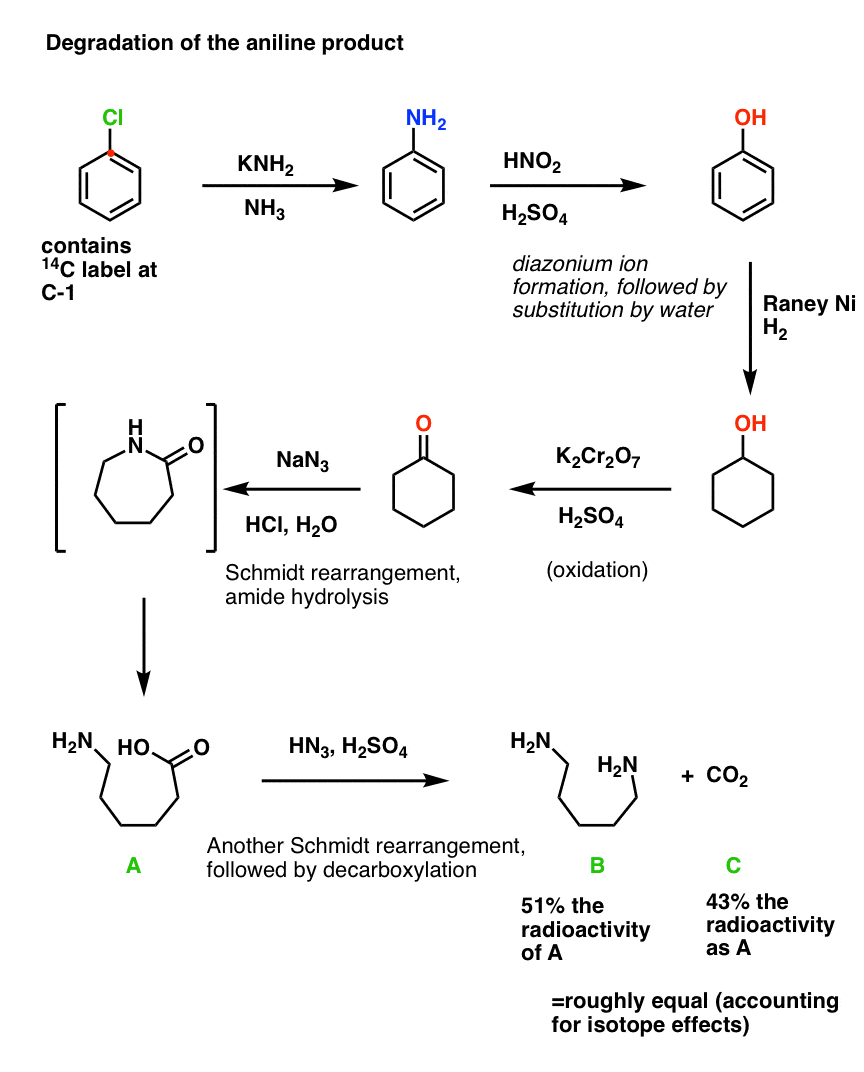
The person who did more than anyone else to develop and popularize the use of NMR as a technique for structure determination of organic compounds, and thereby free us from this misery?
John Roberts, who began working on it shortly after this benzyne study was published.
Quiz Yourself!
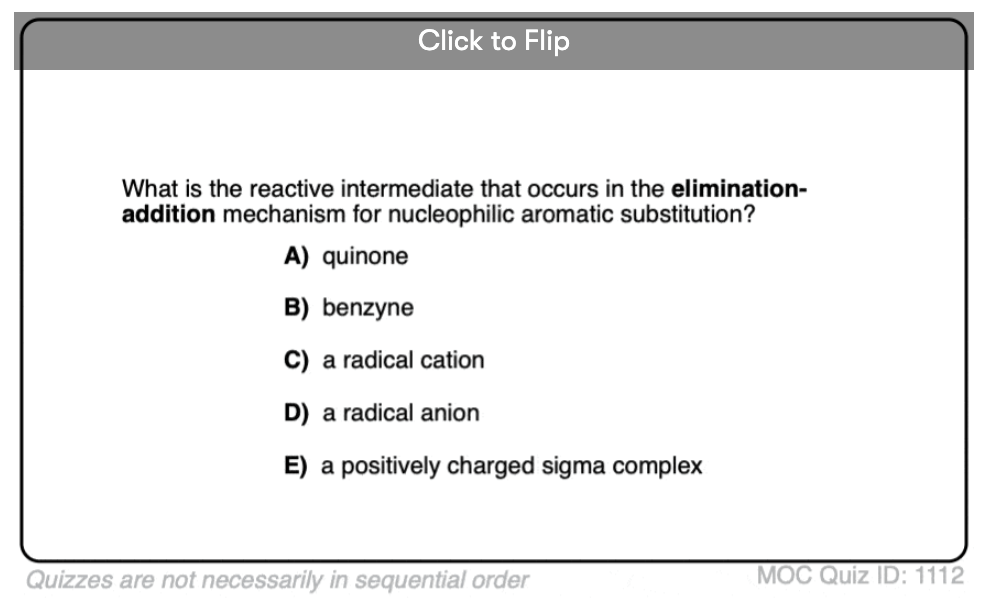
Become a MOC member to see the clickable quiz with answers on the back.
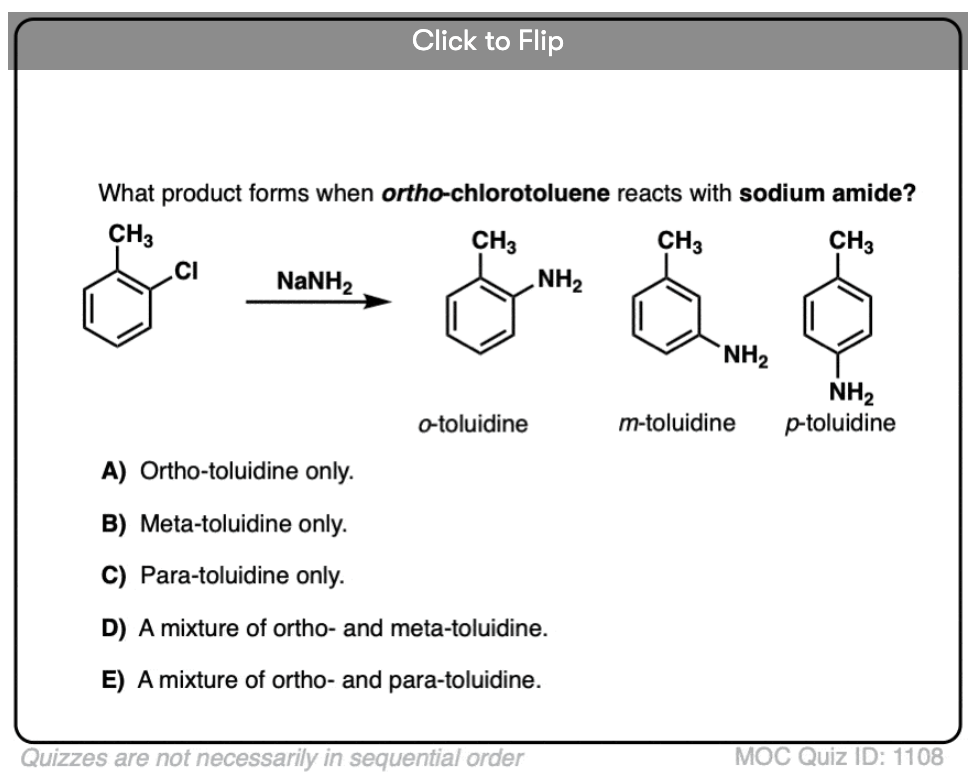
Become a MOC member to see the clickable quiz with answers on the back.
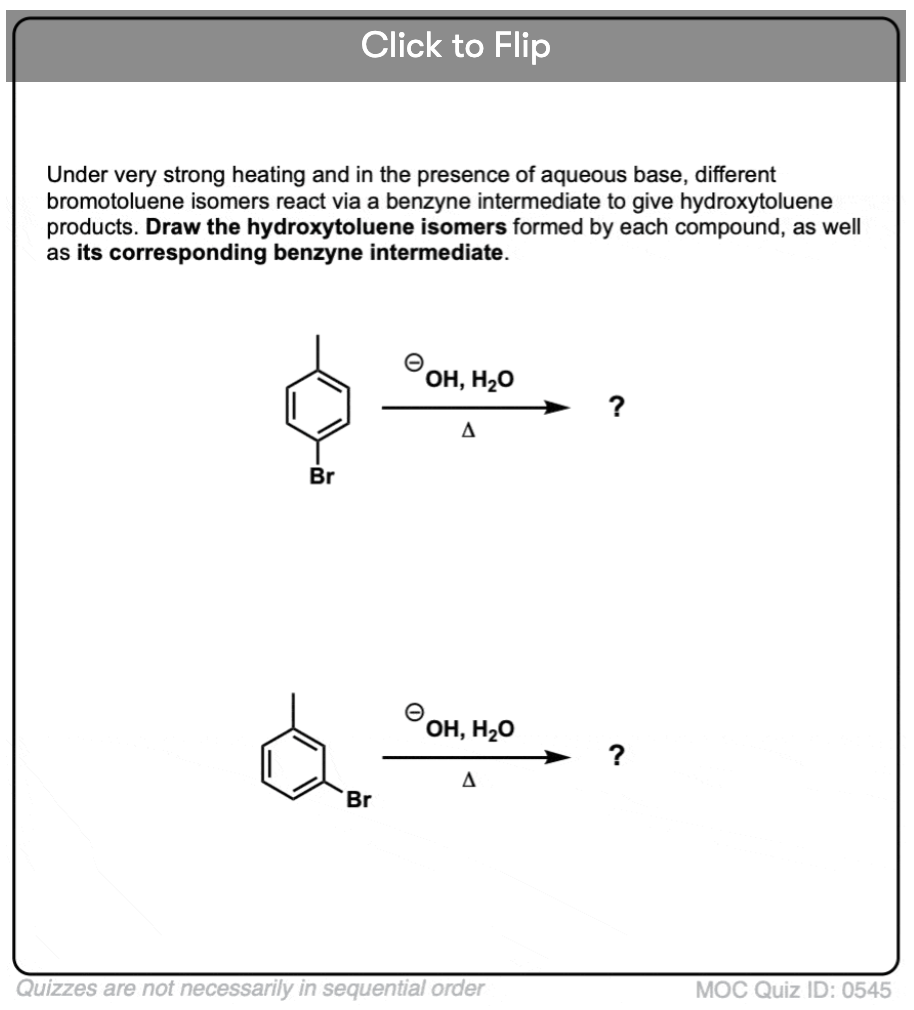
Become a MOC member to see the clickable quiz with answers on the back.

Become a MOC member to see the clickable quiz with answers on the back.
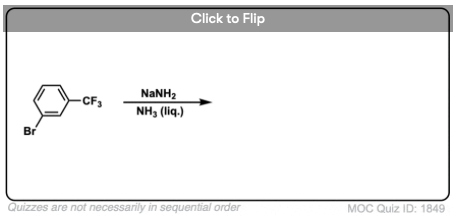
Become a MOC member to see the clickable quiz with answers on the back.
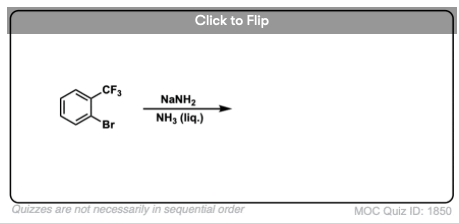
Become a MOC member to see the clickable quiz with answers on the back.
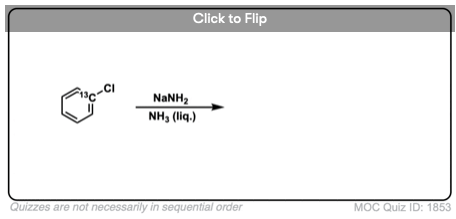
Become a MOC member to see the clickable quiz with answers on the back.
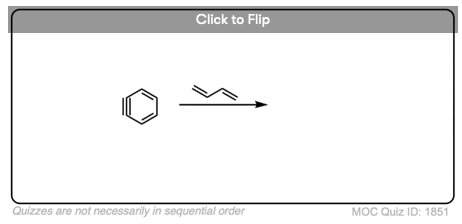
Become a MOC member to see the clickable quiz with answers on the back.
(Advanced) References And Further Reading
In these first two papers, Nobel Laureate Georg Wittig describes reactions of o-fluorophenyllithium and proposes they go through a zwitterionic intermediate (although in paper 2 he does also use a triply bonded structure for o-benzyne).
- Über die Bildung von Diphenyl aus Fluorbenzol und Phenyl‐lithium (IV. Mitteil. über Austauschreaktionen mit Phenyl‐lithium)
Georg Wittig, Gustav Pieper, Gerhard Fuhrmann
Ber. 1940, 73 (11), 1193-1197
DOI: 10.1002/cber.19400731113 - Phenyl-lithium, der Schlüssel zu einer neuen Chemie metallorganischer Verbindungen
Georg Wittig
Naturwissenschaften November 1942, Volume 30, Issue 46–47, pp 696–703
DOI: 1007/BF01489519These papers are classics by Prof. J. D. Roberts in which he used 14C-labeled chlorobenzene and KNH2 to prove the intermediacy of benzyne due to scrambling of the 14C label after the reaction. - REARRANGEMENT IN THE REACTION OF CHLOROBENZENE-1-C14 WITH POTASSIUM AMIDE
John D. Roberts, Howard E. Simmons Jr., L. A. Carlsmith, and C. Wheaton Vaughan
Journal of the American Chemical Society 1953 75 (13), 3290-3291
DOI: 1021/ja01109a523 - The Mechanism of Aminations of Halobenzenes
John D. Roberts, Dorothy A. Semenow, Howard E. Simmons Jr., and L. A. Carlsmith
Journal of the American Chemical Society 1956 78 (3), 601-611
DOI: 1021/ja01584a024 - TRIPTYCENE
Georg Wittig
Org. Syn. 1959, 39, 75
DOI: 10.15227/orgsyn.039.0075
This procedure in Organic Syntheses, a source of reliable and independently tested experimental synthetic organic chemistry procedures, is also from Georg Wittig and is a classical method for preparing benzyne. - FLUORIDE-INDUCED 1,2-ELIMINATION OF O-TRIMETHYLSILYLPHENYL TRIFLATE TO BENZYNE UNDER MILD CONDITIONS
Yoshio Himeshima, Takaaki Sonoda, Hiroshi Kobayashi
Lett. 1983, 1211-1214
DOI: 10.1246/cl.1983.1211
This is an extremely influential paper in organic chemistry, since this chemistry enables the generation of benzyne under extremely mild conditions (room temperature or below). - THE DIRECT ACYL-ALKYLATION OF ARYNES [PREPARATION OF METHYL 2-(2-ACETYLPHENYL)ACETATE]
David C. Ebner, Uttam K. Tambar, and Brian M. Stoltz
Org. Syn. 2009, 86, 161
DOI: 10.15227/orgsyn.086.0161
An example of a modern synthetic procedure involving benzyne, using the chemistry developed by Kobayashi (ref. 6). Prof. Brian Stoltz (Caltech) has developed (and continues to develop) many interesting synthetic methodologies using benzyne. - Indolyne Experimental and Computational Studies: Synthetic Applications and Origins of Selectivities of Nucleophilic Additions
G-Yoon J. Im, Sarah M. Bronner, Adam E. Goetz, Robert S. Paton, Paul H.-Y. Cheong, K. N. Houk, and Neil K. Garg
Journal of the American Chemical Society 2010 132 (50), 17933-17944
DOI: 10.1021/ja1086485
Prof. Neil Garg (UCLA) did his PhD with Prof. Stoltz and has extended the benzyne concept to other heterocycles, such as indole, notably developing chemistry based on ‘indolyne’. - One Century of Aryne Chemistry
Hans Henning Wenk Dr., Michael Winkler Dipl.‐Chem., Wolfram Sander Prof. Dr.
Chem. Int. Ed. 2003, 42 (5), 502-528
DOI: 10.1002/anie.200390151
Nice review on aryne chemistry.
00 General Chemistry Review
01 Bonding, Structure, and Resonance
- How Do We Know Methane (CH4) Is Tetrahedral?
- Hybrid Orbitals and Hybridization
- How To Determine Hybridization: A Shortcut
- Orbital Hybridization And Bond Strengths
- Sigma bonds come in six varieties: Pi bonds come in one
- Dipole Moments and Dipoles
- A Key Skill: How to Calculate Formal Charge
- The Four Intermolecular Forces and How They Affect Boiling Points
- 3 Trends That Affect Boiling Points
- How To Use Electronegativity To Determine Electron Density (and why NOT to trust formal charge)
- Introduction to Resonance
- How To Use Curved Arrows To Interchange Resonance Forms
- Evaluating Resonance Forms (1) - The Rule of Least Charges
- How To Find The Best Resonance Structure By Applying Electronegativity
- Evaluating Resonance Structures With Negative Charges
- Evaluating Resonance Structures With Positive Charge
- Exploring Resonance: Pi-Donation
- Exploring Resonance: Pi-acceptors
- In Summary: Evaluating Resonance Structures
- Drawing Resonance Structures: 3 Common Mistakes To Avoid
- How to apply electronegativity and resonance to understand reactivity
- Bond Hybridization Practice
- Structure and Bonding Practice Quizzes
- Resonance Structures Practice
02 Acid Base Reactions
- Introduction to Acid-Base Reactions
- Acid Base Reactions In Organic Chemistry
- The Stronger The Acid, The Weaker The Conjugate Base
- Walkthrough of Acid-Base Reactions (3) - Acidity Trends
- Five Key Factors That Influence Acidity
- Acid-Base Reactions: Introducing Ka and pKa
- How to Use a pKa Table
- The pKa Table Is Your Friend
- A Handy Rule of Thumb for Acid-Base Reactions
- Acid Base Reactions Are Fast
- pKa Values Span 60 Orders Of Magnitude
- How Protonation and Deprotonation Affect Reactivity
- Acid Base Practice Problems
03 Alkanes and Nomenclature
- Meet the (Most Important) Functional Groups
- Condensed Formulas: Deciphering What the Brackets Mean
- Hidden Hydrogens, Hidden Lone Pairs, Hidden Counterions
- Don't Be Futyl, Learn The Butyls
- Primary, Secondary, Tertiary, Quaternary In Organic Chemistry
- Branching, and Its Affect On Melting and Boiling Points
- The Many, Many Ways of Drawing Butane
- Wedge And Dash Convention For Tetrahedral Carbon
- Common Mistakes in Organic Chemistry: Pentavalent Carbon
- Table of Functional Group Priorities for Nomenclature
- Summary Sheet - Alkane Nomenclature
- Organic Chemistry IUPAC Nomenclature Demystified With A Simple Puzzle Piece Approach
- Boiling Point Quizzes
- Organic Chemistry Nomenclature Quizzes
04 Conformations and Cycloalkanes
- Staggered vs Eclipsed Conformations of Ethane
- Conformational Isomers of Propane
- Newman Projection of Butane (and Gauche Conformation)
- Introduction to Cycloalkanes
- Geometric Isomers In Small Rings: Cis And Trans Cycloalkanes
- Calculation of Ring Strain In Cycloalkanes
- Cycloalkanes - Ring Strain In Cyclopropane And Cyclobutane
- Cyclohexane Conformations
- Cyclohexane Chair Conformation: An Aerial Tour
- How To Draw The Cyclohexane Chair Conformation
- The Cyclohexane Chair Flip
- The Cyclohexane Chair Flip - Energy Diagram
- Substituted Cyclohexanes - Axial vs Equatorial
- Ranking The Bulkiness Of Substituents On Cyclohexanes: "A-Values"
- Cyclohexane Chair Conformation Stability: Which One Is Lower Energy?
- Fused Rings - Cis-Decalin and Trans-Decalin
- Naming Bicyclic Compounds - Fused, Bridged, and Spiro
- Bredt's Rule (And Summary of Cycloalkanes)
- Newman Projection Practice
- Cycloalkanes Practice Problems
05 A Primer On Organic Reactions
- The Most Important Question To Ask When Learning a New Reaction
- Curved Arrows (for reactions)
- Nucleophiles and Electrophiles
- The Three Classes of Nucleophiles
- Nucleophilicity vs. Basicity
- What Makes A Good Nucleophile?
- What Makes A Good Leaving Group?
- 3 Factors That Stabilize Carbocations
- Equilibrium and Energy Relationships
- 7 Factors that stabilize negative charge in organic chemistry
- 7 Factors That Stabilize Positive Charge in Organic Chemistry
- What's a Transition State?
- Hammond's Postulate
- Learning Organic Chemistry Reactions: A Checklist (PDF)
06 Free Radical Reactions
- Free Radical Reactions
- 3 Factors That Stabilize Free Radicals
- Bond Strengths And Radical Stability
- Free Radical Initiation: Why Is "Light" Or "Heat" Required?
- Initiation, Propagation, Termination
- Monochlorination Products Of Propane, Pentane, And Other Alkanes
- Selectivity In Free Radical Reactions
- Selectivity in Free Radical Reactions: Bromination vs. Chlorination
- Halogenation At Tiffany's
- Allylic Bromination
- Bonus Topic: Allylic Rearrangements
- In Summary: Free Radicals
- Synthesis (2) - Reactions of Alkanes
- Free Radicals Practice Quizzes
07 Stereochemistry and Chirality
- Types of Isomers: Constitutional Isomers, Stereoisomers, Enantiomers, and Diastereomers
- How To Draw The Enantiomer Of A Chiral Molecule
- How To Draw A Bond Rotation
- Introduction to Assigning (R) and (S): The Cahn-Ingold-Prelog Rules
- Assigning Cahn-Ingold-Prelog (CIP) Priorities (2) - The Method of Dots
- Enantiomers vs Diastereomers vs The Same? Two Methods For Solving Problems
- Assigning R/S To Newman Projections (And Converting Newman To Line Diagrams)
- How To Determine R and S Configurations On A Fischer Projection
- The Meso Trap
- Optical Rotation, Optical Activity, and Specific Rotation
- Optical Purity and Enantiomeric Excess
- What's a Racemic Mixture?
- Chiral Allenes And Chiral Axes
- Stereochemistry Practice Problems and Quizzes
08 Substitution Reactions
- Nucleophilic Substitution Reactions - Introduction
- Two Types of Nucleophilic Substitution Reactions
- The SN2 Mechanism
- Why the SN2 Reaction Is Powerful
- The SN1 Mechanism
- The Conjugate Acid Is A Better Leaving Group
- Comparing the SN1 and SN2 Reactions
- Polar Protic? Polar Aprotic? Nonpolar? All About Solvents
- Steric Hindrance is Like a Fat Goalie
- Common Blind Spot: Intramolecular Reactions
- Substitution Practice - SN1
- Substitution Practice - SN2
09 Elimination Reactions
- Elimination Reactions (1): Introduction And The Key Pattern
- Elimination Reactions (2): The Zaitsev Rule
- Elimination Reactions Are Favored By Heat
- Two Elimination Reaction Patterns
- The E1 Reaction
- The E2 Mechanism
- E1 vs E2: Comparing the E1 and E2 Reactions
- Antiperiplanar Relationships: The E2 Reaction and Cyclohexane Rings
- Bulky Bases in Elimination Reactions
- Comparing the E1 vs SN1 Reactions
- Elimination (E1) Reactions With Rearrangements
- E1cB - Elimination (Unimolecular) Conjugate Base
- Elimination (E1) Practice Problems And Solutions
- Elimination (E2) Practice Problems and Solutions
10 Rearrangements
11 SN1/SN2/E1/E2 Decision
- Identifying Where Substitution and Elimination Reactions Happen
- Deciding SN1/SN2/E1/E2 (1) - The Substrate
- Deciding SN1/SN2/E1/E2 (2) - The Nucleophile/Base
- SN1 vs E1 and SN2 vs E2 : The Temperature
- Deciding SN1/SN2/E1/E2 - The Solvent
- Wrapup: The Key Factors For Determining SN1/SN2/E1/E2
- Alkyl Halide Reaction Map And Summary
- SN1 SN2 E1 E2 Practice Problems
12 Alkene Reactions
- E and Z Notation For Alkenes (+ Cis/Trans)
- Alkene Stability
- Alkene Addition Reactions: "Regioselectivity" and "Stereoselectivity" (Syn/Anti)
- Stereoselective and Stereospecific Reactions
- Hydrohalogenation of Alkenes and Markovnikov's Rule
- Hydration of Alkenes With Aqueous Acid
- Rearrangements in Alkene Addition Reactions
- Halogenation of Alkenes and Halohydrin Formation
- Oxymercuration Demercuration of Alkenes
- Hydroboration Oxidation of Alkenes
- m-CPBA (meta-chloroperoxybenzoic acid)
- OsO4 (Osmium Tetroxide) for Dihydroxylation of Alkenes
- Palladium on Carbon (Pd/C) for Catalytic Hydrogenation of Alkenes
- Cyclopropanation of Alkenes
- A Fourth Alkene Addition Pattern - Free Radical Addition
- Alkene Reactions: Ozonolysis
- Oxidative Cleavage of Vicinal Diols With NaIO4 and Pb(OAc)4
- Summary: Three Key Families Of Alkene Reaction Mechanisms
- Synthesis (4) - Alkene Reaction Map, Including Alkyl Halide Reactions
- Alkene Reactions Practice Problems
13 Alkyne Reactions
- Acetylides from Alkynes, And Substitution Reactions of Acetylides
- Partial Reduction of Alkynes With Lindlar's Catalyst
- Partial Reduction of Alkynes With Na/NH3 To Obtain Trans Alkenes
- Alkyne Hydroboration With "R2BH"
- Hydration and Oxymercuration of Alkynes
- Hydrohalogenation of Alkynes
- Alkyne Halogenation: Bromination and Chlorination of Alkynes
- Oxidation of Alkynes With O3 and KMnO4
- Alkenes To Alkynes Via Halogenation And Elimination Reactions
- Alkynes Are A Blank Canvas
- Synthesis (5) - Reactions of Alkynes
- Alkyne Reactions Practice Problems With Answers
14 Alcohols, Epoxides and Ethers
- Alcohols - Nomenclature and Properties
- Alcohols Can Act As Acids Or Bases (And Why It Matters)
- Alcohols - Acidity and Basicity
- The Williamson Ether Synthesis
- Ethers From Alkenes, Tertiary Alkyl Halides and Alkoxymercuration
- Alcohols To Ethers via Acid Catalysis
- Cleavage Of Ethers With Acid
- Epoxides - The Outlier Of The Ether Family
- Opening of Epoxides With Acid
- Epoxide Ring Opening With Base
- Making Alkyl Halides From Alcohols
- Tosylates And Mesylates
- PBr3 and SOCl2
- Elimination Reactions of Alcohols
- Elimination of Alcohols To Alkenes With POCl3
- Alcohol Oxidation: "Strong" and "Weak" Oxidants
- Demystifying The Mechanisms of Alcohol Oxidations
- Protecting Groups For Alcohols
- Thiols And Thioethers
- Calculating the oxidation state of a carbon
- Oxidation and Reduction in Organic Chemistry
- Oxidation Ladders
- SOCl2 Mechanism For Alcohols To Alkyl Halides: SN2 versus SNi
- Alcohol Reactions Roadmap (PDF)
- Alcohol Reaction Practice Problems
- Epoxide Reaction Quizzes
- Oxidation and Reduction Practice Quizzes
15 Organometallics
- What's An Organometallic?
- Formation of Grignard and Organolithium Reagents
- Organometallics Are Strong Bases
- Reactions of Grignard Reagents
- Protecting Groups In Grignard Reactions
- Synthesis Problems Involving Grignard Reagents
- Grignard Reactions And Synthesis (2)
- Organocuprates (Gilman Reagents): How They're Made
- Gilman Reagents (Organocuprates): What They're Used For
- The Heck, Suzuki, and Olefin Metathesis Reactions (And Why They Don't Belong In Most Introductory Organic Chemistry Courses)
- Reaction Map: Reactions of Organometallics
- Grignard Practice Problems
16 Spectroscopy
- Degrees of Unsaturation (or IHD, Index of Hydrogen Deficiency)
- Conjugation And Color (+ How Bleach Works)
- Introduction To UV-Vis Spectroscopy
- UV-Vis Spectroscopy: Absorbance of Carbonyls
- UV-Vis Spectroscopy: Practice Questions
- Bond Vibrations, Infrared Spectroscopy, and the "Ball and Spring" Model
- Infrared (IR) Spectroscopy: A Quick Primer On Interpreting Spectra
- IR Spectroscopy: 4 Practice Problems
- 1H NMR: How Many Signals?
- Homotopic, Enantiotopic, Diastereotopic
- Diastereotopic Protons in 1H NMR Spectroscopy: Examples
- 13-C NMR - How Many Signals
- Liquid Gold: Pheromones In Doe Urine
- Natural Product Isolation (1) - Extraction
- Natural Product Isolation (2) - Purification Techniques, An Overview
- Structure Determination Case Study: Deer Tarsal Gland Pheromone
17 Dienes and MO Theory
- What To Expect In Organic Chemistry 2
- Are these molecules conjugated?
- Conjugation And Resonance In Organic Chemistry
- Bonding And Antibonding Pi Orbitals
- Molecular Orbitals of The Allyl Cation, Allyl Radical, and Allyl Anion
- Pi Molecular Orbitals of Butadiene
- Reactions of Dienes: 1,2 and 1,4 Addition
- Thermodynamic and Kinetic Products
- More On 1,2 and 1,4 Additions To Dienes
- s-cis and s-trans
- The Diels-Alder Reaction
- Cyclic Dienes and Dienophiles in the Diels-Alder Reaction
- Stereochemistry of the Diels-Alder Reaction
- Exo vs Endo Products In The Diels Alder: How To Tell Them Apart
- HOMO and LUMO In the Diels Alder Reaction
- Why Are Endo vs Exo Products Favored in the Diels-Alder Reaction?
- Diels-Alder Reaction: Kinetic and Thermodynamic Control
- The Retro Diels-Alder Reaction
- The Intramolecular Diels Alder Reaction
- Regiochemistry In The Diels-Alder Reaction
- The Cope and Claisen Rearrangements
- Electrocyclic Reactions
- Electrocyclic Ring Opening And Closure (2) - Six (or Eight) Pi Electrons
- Diels Alder Practice Problems
- Molecular Orbital Theory Practice
18 Aromaticity
- Introduction To Aromaticity
- Rules For Aromaticity
- Huckel's Rule: What Does 4n+2 Mean?
- Aromatic, Non-Aromatic, or Antiaromatic? Some Practice Problems
- Antiaromatic Compounds and Antiaromaticity
- The Pi Molecular Orbitals of Benzene
- The Pi Molecular Orbitals of Cyclobutadiene
- Frost Circles
- Aromaticity Practice Quizzes
19 Reactions of Aromatic Molecules
- Electrophilic Aromatic Substitution: Introduction
- Activating and Deactivating Groups In Electrophilic Aromatic Substitution
- Electrophilic Aromatic Substitution - The Mechanism
- Ortho-, Para- and Meta- Directors in Electrophilic Aromatic Substitution
- Understanding Ortho, Para, and Meta Directors
- Why are halogens ortho- para- directors?
- Disubstituted Benzenes: The Strongest Electron-Donor "Wins"
- Electrophilic Aromatic Substitutions (1) - Halogenation of Benzene
- Electrophilic Aromatic Substitutions (2) - Nitration and Sulfonation
- EAS Reactions (3) - Friedel-Crafts Acylation and Friedel-Crafts Alkylation
- Intramolecular Friedel-Crafts Reactions
- Nucleophilic Aromatic Substitution (NAS)
- Nucleophilic Aromatic Substitution (2) - The Benzyne Mechanism
- Reactions on the "Benzylic" Carbon: Bromination And Oxidation
- The Wolff-Kishner, Clemmensen, And Other Carbonyl Reductions
- More Reactions on the Aromatic Sidechain: Reduction of Nitro Groups and the Baeyer Villiger
- Aromatic Synthesis (1) - "Order Of Operations"
- Synthesis of Benzene Derivatives (2) - Polarity Reversal
- Aromatic Synthesis (3) - Sulfonyl Blocking Groups
- Birch Reduction
- Synthesis (7): Reaction Map of Benzene and Related Aromatic Compounds
- Aromatic Reactions and Synthesis Practice
- Electrophilic Aromatic Substitution Practice Problems
20 Aldehydes and Ketones
- What's The Alpha Carbon In Carbonyl Compounds?
- Nucleophilic Addition To Carbonyls
- Aldehydes and Ketones: 14 Reactions With The Same Mechanism
- Sodium Borohydride (NaBH4) Reduction of Aldehydes and Ketones
- Grignard Reagents For Addition To Aldehydes and Ketones
- Wittig Reaction
- Hydrates, Hemiacetals, and Acetals
- Imines - Properties, Formation, Reactions, and Mechanisms
- All About Enamines
- Breaking Down Carbonyl Reaction Mechanisms: Reactions of Anionic Nucleophiles (Part 2)
- Aldehydes Ketones Reaction Practice
21 Carboxylic Acid Derivatives
- Nucleophilic Acyl Substitution (With Negatively Charged Nucleophiles)
- Addition-Elimination Mechanisms With Neutral Nucleophiles (Including Acid Catalysis)
- Basic Hydrolysis of Esters - Saponification
- Transesterification
- Proton Transfer
- Fischer Esterification - Carboxylic Acid to Ester Under Acidic Conditions
- Lithium Aluminum Hydride (LiAlH4) For Reduction of Carboxylic Acid Derivatives
- LiAlH[Ot-Bu]3 For The Reduction of Acid Halides To Aldehydes
- Di-isobutyl Aluminum Hydride (DIBAL) For The Partial Reduction of Esters and Nitriles
- Amide Hydrolysis
- Thionyl Chloride (SOCl2) And Conversion of Carboxylic Acids to Acid Halides
- Diazomethane (CH2N2)
- Carbonyl Chemistry: Learn Six Mechanisms For the Price Of One
- Making Music With Mechanisms (PADPED)
- Carboxylic Acid Derivatives Practice Questions
22 Enols and Enolates
- Keto-Enol Tautomerism
- Enolates - Formation, Stability, and Simple Reactions
- Kinetic Versus Thermodynamic Enolates
- Aldol Addition and Condensation Reactions
- Reactions of Enols - Acid-Catalyzed Aldol, Halogenation, and Mannich Reactions
- Claisen Condensation and Dieckmann Condensation
- Decarboxylation
- The Malonic Ester and Acetoacetic Ester Synthesis
- The Michael Addition Reaction and Conjugate Addition
- The Robinson Annulation
- Haloform Reaction
- The Hell–Volhard–Zelinsky Reaction
- Enols and Enolates Practice Quizzes
23 Amines
- The Amide Functional Group: Properties, Synthesis, and Nomenclature
- Basicity of Amines And pKaH
- 5 Key Basicity Trends of Amines
- The Mesomeric Effect And Aromatic Amines
- Nucleophilicity of Amines
- Alkylation of Amines (Sucks!)
- Reductive Amination
- The Gabriel Synthesis
- Some Reactions of Azides
- The Hofmann Elimination
- The Hofmann and Curtius Rearrangements
- The Cope Elimination
- Protecting Groups for Amines - Carbamates
- The Strecker Synthesis of Amino Acids
- Introduction to Peptide Synthesis
- Reactions of Diazonium Salts: Sandmeyer and Related Reactions
- Amine Practice Questions
24 Carbohydrates
- D and L Notation For Sugars
- Pyranoses and Furanoses: Ring-Chain Tautomerism In Sugars
- What is Mutarotation?
- Reducing Sugars
- The Big Damn Post Of Carbohydrate-Related Chemistry Definitions
- The Haworth Projection
- Converting a Fischer Projection To A Haworth (And Vice Versa)
- Reactions of Sugars: Glycosylation and Protection
- The Ruff Degradation and Kiliani-Fischer Synthesis
- Isoelectric Points of Amino Acids (and How To Calculate Them)
- Carbohydrates Practice
- Amino Acid Quizzes
25 Fun and Miscellaneous
- A Gallery of Some Interesting Molecules From Nature
- Screw Organic Chemistry, I'm Just Going To Write About Cats
- On Cats, Part 1: Conformations and Configurations
- On Cats, Part 2: Cat Line Diagrams
- On Cats, Part 4: Enantiocats
- On Cats, Part 6: Stereocenters
- Organic Chemistry Is Shit
- The Organic Chemistry Behind "The Pill"
- Maybe they should call them, "Formal Wins" ?
- Why Do Organic Chemists Use Kilocalories?
- The Principle of Least Effort
- Organic Chemistry GIFS - Resonance Forms
- Reproducibility In Organic Chemistry
- What Holds The Nucleus Together?
- How Reactions Are Like Music
- Organic Chemistry and the New MCAT
26 Organic Chemistry Tips and Tricks
- Common Mistakes: Formal Charges Can Mislead
- Partial Charges Give Clues About Electron Flow
- Draw The Ugly Version First
- Organic Chemistry Study Tips: Learn the Trends
- The 8 Types of Arrows In Organic Chemistry, Explained
- Top 10 Skills To Master Before An Organic Chemistry 2 Final
- Common Mistakes with Carbonyls: Carboxylic Acids... Are Acids!
- Planning Organic Synthesis With "Reaction Maps"
- Alkene Addition Pattern #1: The "Carbocation Pathway"
- Alkene Addition Pattern #2: The "Three-Membered Ring" Pathway
- Alkene Addition Pattern #3: The "Concerted" Pathway
- Number Your Carbons!
- The 4 Major Classes of Reactions in Org 1
- How (and why) electrons flow
- Grossman's Rule
- Three Exam Tips
- A 3-Step Method For Thinking Through Synthesis Problems
- Putting It Together
- Putting Diels-Alder Products in Perspective
- The Ups and Downs of Cyclohexanes
- The Most Annoying Exceptions in Org 1 (Part 1)
- The Most Annoying Exceptions in Org 1 (Part 2)
- The Marriage May Be Bad, But the Divorce Still Costs Money
- 9 Nomenclature Conventions To Know
- Nucleophile attacks Electrophile
27 Case Studies of Successful O-Chem Students
- Success Stories: How Corina Got The The "Hard" Professor - And Got An A+ Anyway
- How Helena Aced Organic Chemistry
- From a "Drop" To B+ in Org 2 – How A Hard Working Student Turned It Around
- How Serge Aced Organic Chemistry
- Success Stories: How Zach Aced Organic Chemistry 1
- Success Stories: How Kari Went From C– to B+
- How Esther Bounced Back From a "C" To Get A's In Organic Chemistry 1 And 2
- How Tyrell Got The Highest Grade In Her Organic Chemistry Course
- This Is Why Students Use Flashcards
- Success Stories: How Stu Aced Organic Chemistry
- How John Pulled Up His Organic Chemistry Exam Grades
- Success Stories: How Nathan Aced Organic Chemistry (Without It Taking Over His Life)
- How Chris Aced Org 1 and Org 2
- Interview: How Jay Got an A+ In Organic Chemistry
- How to Do Well in Organic Chemistry: One Student's Advice
- "America's Top TA" Shares His Secrets For Teaching O-Chem
- "Organic Chemistry Is Like..." - A Few Metaphors
- How To Do Well In Organic Chemistry: Advice From A Tutor
- Guest post: "I went from being afraid of tests to actually looking forward to them".
This is a very informative post! However there’s a doubt with CF3 substituent. Cf3 shows negative hyperconjugation which doesn’t act at meta positions(only at ortho and para)..So shouldn’t that stabilize the anion/negative charge at para position more as opposed to at meta position. Shouldn’t -Nh2 then be attached to meta position in the major product and not to para position then..?
How protic and aprotic solvent effect benzyne formation. (Brief explanation needed)
So wellexplained and helpful! Your clear and lucid language really helps me a lot in understanding many important topics. Whenever I look for doubt clearance with respect to organic chemistry and I find your post, I know they’re gonna be well looked after. With tons of thanks, from India.🙏🙏
Thank you
Thankyou so much. All content in this website is very informative
Thank you sir.It helps me to understand this concept which is very important for indian competitive exams.
Excellent ..the way you divided & explained the concept🤩
Well done for the teaching☺☺
Informative post.. just a quick question… how do we decide if a reaction proceeds in the normal Addition Elimination Mechanism or the Benzyne Mechanism.. any parameters like temperature/reagent, etc?
Look for the presence of strong base (NaNH2) in the case of aryne formation.
Amazing content! Thank you!
I had some confusion however ; in the question posed in the flashcard (“Quiz Yourself!”) the second case deals with a substituent at meta position. The solution gives two possible Benzyne intermediates ; one with the triple bond between m,p and one at o,p. How do we decide/expect which one will be major?
Thanks a ton .Amazing as always. Probably the best few pages on benzyne. Salute to you sir
Nice post!! But I have a doubt…
Why doesn’t resonance occur in benzyne? Is it because it loses aromaticity?
Is that the reason why we don’t consider resonance effect of the substituent while deciding the product?
The “triple bond” in benzyne is in orbitals that are at 90° to the aromatic pi system. They are not able to interact with the orbitals that comprise the aromatic ring.
love From INDIA..
in our culture teachers are god to us..
u proved to be one definitely!
I don’t understand why all my textbooks (Clayden, Yurkanis, Vollhardt) show that the NH2- is the nucleophile and NEVER the NH3! It makes so much sense with the NH3 and your explanation. Even my professor taught it with the NH2-. Now I don’t know how I will write it in my test. Do you have any book that talks about this?
Thanks for such a great website by the way! Greeting from Germany
Just to be sure, the rate determining step is the second one, with the attack of the nucleophile on the aryne intermediate, right? I couldn’t find a mention of that in the post.
No, rate determining step is formation of the aryne (deprotonation). The attack is fast.
excellent I always use these helpful posts and recommend it to my friends, all the posts are great, thank you very much
Excellent post, as expected. One minor thing, though:
“Benzyne Undergoes Diels Alder Reactions
dienes in a Diels-Alder reaction. The triple bond of benzyne acts as a dienophile:”
It looks like the 1st part of the 1st phrase is missing.
Shoot. Thank you! Fixed.
Great post, James!
I just wanted to point out what is probably a copy/paste error in your discussion of the regioselectivity of substituted arynes. In case #2 (when the triple bond is between the ortho and meta carbons), you’ve drawn both products as having the same structure, and the accompanying text in the ChemDraw is incorrect.
Also, you might be interested in this nice write-up of Jack Roberts: https://onlinelibrary.wiley.com/doi/abs/10.1002/anie.201612152
Oh dear. Thanks for catching that, Harold! Fixed.
Hey! Mistake is still there, just so you know.
Thanks for all you posts though! They’ve been a huge help!
Fixed it (finally). thanks for nagging me!